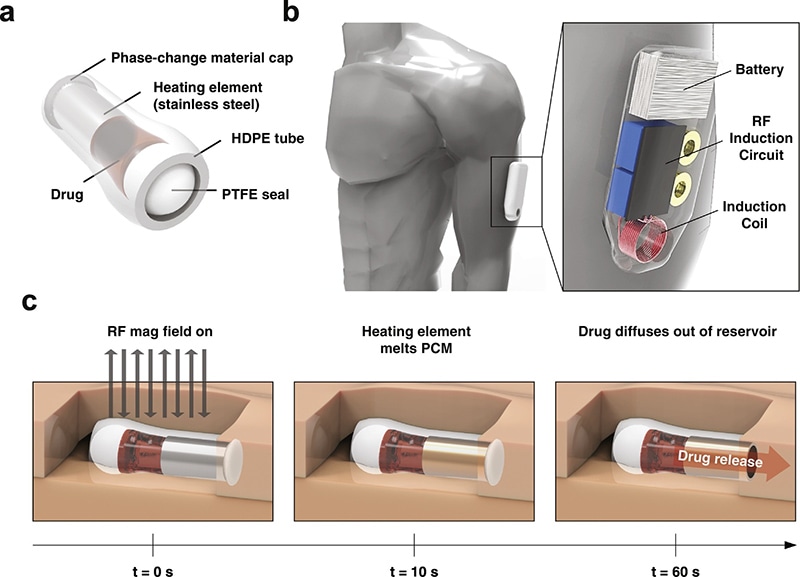Jul 29 2019
Opioid overdose can make individuals isolated and incapacitated. Now, researchers at Purdue University are creating a unique device that would automatically identify an overdose and deliver naloxone—a drug that reverses deadly effects.
 Purdue researchers are developing a wearable device that would automatically deliver an antidote upon detecting opioid overdose, buying time for emergency services to arrive. (Image credit: Purdue University image/Jongcheon Lim)
Purdue researchers are developing a wearable device that would automatically deliver an antidote upon detecting opioid overdose, buying time for emergency services to arrive. (Image credit: Purdue University image/Jongcheon Lim)
The antidote is always going to be with you. The device wouldn’t require you to recognize that you’re having an overdose or to inject yourself with naloxone, keeping you stable long enough for emergency services to arrive.
Hyowon “Hugh” Lee, Assistant Professor, Biomedical Engineering, Purdue University
An overdose occurs when opioids adhere to brain receptors that control breathing, causing individuals to hypoventilate and die. Approximately 130 people in the United States die each day from opioid-related drug overdoses, according to the U.S. Department of Health and Human Services.
Lee’s group has developed a new wearable device that can detect the point at which the respiration rate of a person reduces to a specific level—changed from electrocardiography (EKG) signals—and subsequently releases the drug naloxone. This drug blocks the opioid from adhering to brain receptors.
Wearing this novel device would be just like wearing an insulin pump: The present proof of concept is an armband that fastens to a magnetic field generator, linked to a portable battery worn at the hip.
Respiration rate is measured by a sticker-like EKG sensor on the skin, for example, on the chest. Upon detecting a respiration rate that is too low, the sensor triggers the magnetic field generator to warm up a drug capsule within the body and discharges the naloxone drug in 10 seconds.
The investigators believe that the drug capsule can be pre-injected within the skin in an outpatient setting. That way, the device would be able to automatically deliver the naloxone drug to the patient in the event of an overdose, buying approximately an hour before relapsing. That extra hour would give sufficient time to emergency services to get the patient to the hospital, Lee added.
In addition, the capsule delivers a larger dose of naloxone when compared to commercially available products—rendering it more effective at delaying relapse—and would be more economical to develop.
While the device is yet to operate automatically, the team showed through in vivo and in vitro experiments that the setup effectively identifies a low rate of respiration from EKG signals and delivers the naloxone drug. The results of the study have been reported in the Journal of Controlled Release.
The novel device has been patented through the Purdue Research Foundation Office of Technology Commercialization. Since submitting the work for publication, the team has miniaturized the magnetic field battery generator and battery so that the device is not considerably bulky.
The goal is to make the whole system unobtrusive, so that you don’t feel like you’re having to wear something large all the time.
Hyowon “Hugh” Lee, Assistant Professor, Biomedical Engineering, Purdue University
The investigators are also planning to construct a communications system into the unique device that would automatically warn emergency services whenever the patient has overdosed.
The new technology can potentially deliver other kinds of drugs, in addition to naloxone.
“People with allergies need epinephrine right away. This setup might remove the need for an epi pen,” Lee stated.
Lee’s group constructed the device in association with Purdue biomedical engineering professors Chi Hwan Lee, Jacqueline Linnes, and Craig Goergen. The study was supported by an administrative supplement to a grant from the National Institute on Drug Abuse (5U01DA038886-02) and a fellowship by the National Science Foundation (DGE-1333468).
The study aligns with Purdue’s Giant Leaps celebration, acknowledging the university’s global advancements made in longevity, health, and quality of life as part of Purdue’s 150th anniversary. This is one among the four themes of the yearlong celebration’s Ideas Festival, designed to demonstrate Purdue as an intellectual hub solving real-world problems.
Autonomous Device for Reversing Opioid Overdoses
A Purdue University team of engineers has built a wearable device designed to automatically detect when a person's respiration rate decreases to a certain level - converted from electrocardiography (EKG) signals - and then release naloxone, which blocks the opioid from binding to brain receptors. (Video credit: Purdue University video/Erin Easterling)